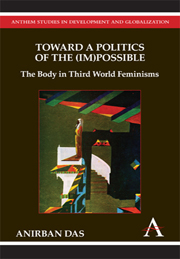Book contents
- Frontmatter
- Contents
- Acknowledgements
- Introduction
- 1 Body, Power and Ideology
- 2 Thinking the Body: Metaphoricity of the Corporeal
- 3 Thinking the Body: Negotiating the Other/Death
- 4 Thinking the Body: Beyond the Topos of Man
- 5 Violence and Responsibility: Embodied Feminisms
- In Conclusion: Toward a Politics of the (Im)Possible
- Notes
- Bibliography
- Index
4 - Thinking the Body: Beyond the Topos of Man
Published online by Cambridge University Press: 05 March 2012
- Frontmatter
- Contents
- Acknowledgements
- Introduction
- 1 Body, Power and Ideology
- 2 Thinking the Body: Metaphoricity of the Corporeal
- 3 Thinking the Body: Negotiating the Other/Death
- 4 Thinking the Body: Beyond the Topos of Man
- 5 Violence and Responsibility: Embodied Feminisms
- In Conclusion: Toward a Politics of the (Im)Possible
- Notes
- Bibliography
- Index
Summary
Introduction
The body is not one. This is a commonplace in the postmodern parlance. But how is the body rendered many? If the body of the individual is the unit of this multiplicity, that is, if bodies are many by virtue of the multiplicity of individuals who have bodies, at least two problems arise. The first, the logical problem, is that of defining the features of this universal category named the body – by what logical step does one mark and name a generality, the body, out of the particular individual bodies. The second problem arises out of the historicity of the category of individual – what about bodies of people who themselves do not mark their selves as individuals bounded by the proper definitions of the body. And both these questions show that once the im-mediate presence of the three dimensional space of the body is put under scrutiny, the obviousness of the individual as the unit of multiplicity gets displaced. One can then think of the singularities of the body at different registers – across identities (the body marked by caste, class, coloniality or gender) – being haunted by its others in each of these registers.
In Chapter Two, we have discussed the need of addressing the roles of ideology along with those of power in the construction of the neutrality of the sexed body as a thing.
- Type
- Chapter
- Information
- Toward a Politics of the (Im)PossibleThe Body in Third World Feminisms, pp. 105 - 132Publisher: Anthem PressPrint publication year: 2010



